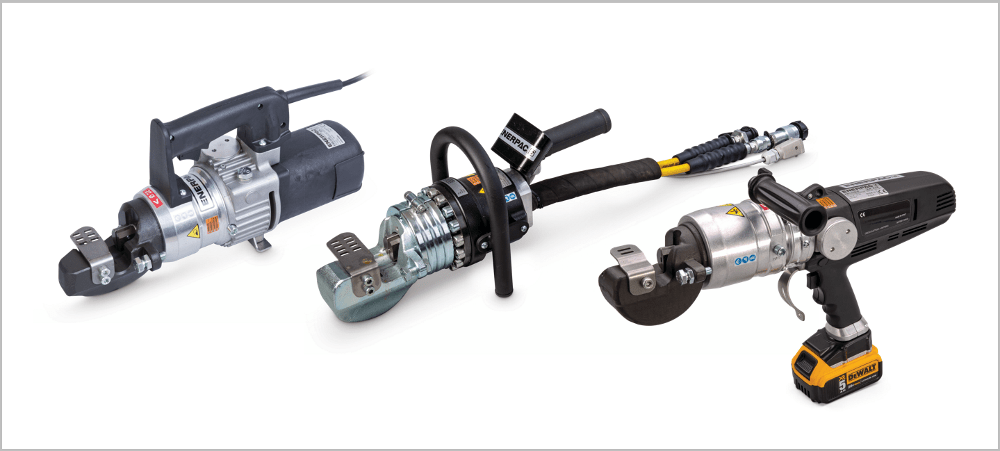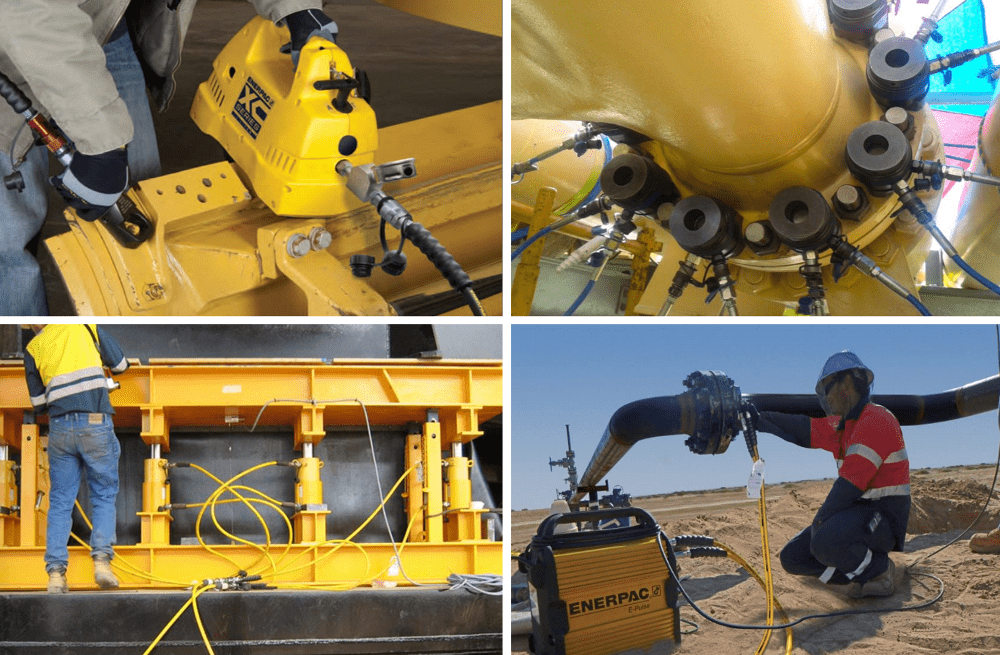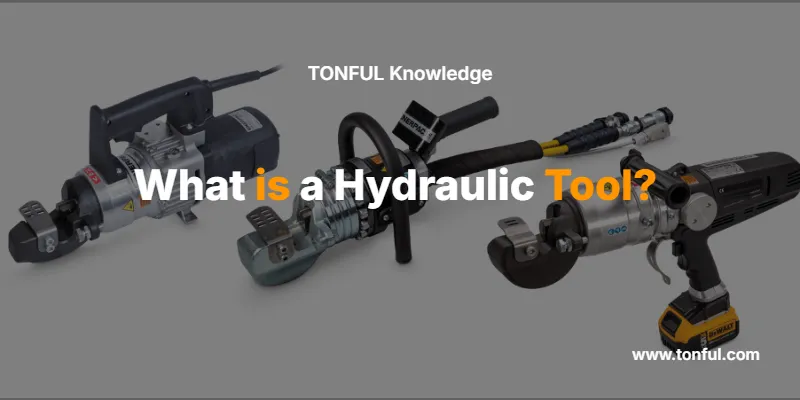A hydraulic tool is a power tool that uses pressurized hydraulic fluid (typically oil) to generate mechanical force for lifting, cutting, bending, or pressing operations. These tools deliver exceptional power-to-weight ratios, making them essential for heavy-duty industrial, construction, and maintenance applications where manual tools would be inadequate.
Hydraulic tools operate on Pascal’s principle, where a small force applied to a small piston creates a much larger force through a larger piston via pressurized fluid. This fundamental mechanism allows compact tools to generate tremendous force—often exceeding 10,000 PSI—making them indispensable for professional operations requiring precision and power.

Key Definitions: Understanding Hydraulic Tool Fundamentals
What Makes a Tool “Hydraulic”?
Hydraulic System Components:
- Hydraulic pump: Creates pressurized fluid flow
- Hydraulic cylinder: Converts fluid pressure into linear motion
- Hydraulic motor: Converts fluid pressure into rotational motion
- Hydraulic fluid: Transmits power (usually specialized hydraulic oil)
- Control valves: Direct fluid flow and pressure
- Reservoir: Stores hydraulic fluid
🔧 Expert Tip: True hydraulic tools differ from pneumatic tools by using incompressible liquid rather than compressed air, providing more consistent force and better control for precision operations.
How Hydraulic Tools Generate Power
Hydraulic tools multiply force through Pascal’s Law: pressure applied to confined fluid transmits equally in all directions. When you apply 100 pounds of force to a 1-square-inch piston, it creates 100 PSI throughout the system. This pressure acting on a 10-square-inch piston generates 1,000 pounds of force—a 10:1 mechanical advantage.
Comprehensive Types of Hydraulic Tools Comparison
Here is a table that shows the main categories of hydraulic tools and their primary applications:
| Tool Category | Primary Function | Force Range | Common Applications | Professional Use |
|---|---|---|---|---|
| Hydraulic Jacks | Lifting/Supporting | 2-100+ tons | Vehicle service, construction, heavy machinery | Automotive shops, construction sites |
| Hydraulic Cylinders | Linear force application | 1-500+ tons | Manufacturing, construction, material handling | Industrial facilities, assembly lines |
| Hydraulic Presses | Compression/Forming | 10-10,000+ tons | Metal fabrication, bearing installation | Machine shops, manufacturing plants |
| Hydraulic Cutters | Cutting/Shearing | 5-200 tons cutting force | Cable cutting, rebar cutting, demolition | Electrical work, construction, emergency rescue |
| Hydraulic Spreaders | Spreading/Prying | 10-100 tons spreading force | Rescue operations, demolition | Emergency services, construction |
| Hydraulic Pullers | Extraction/Removal | 5-150 tons pulling force | Bearing removal, gear extraction | Automotive repair, industrial maintenance |
| Hydraulic Torque Wrenches | Precise bolt tightening | 100-40,000+ ft-lbs | Wind turbines, pipeline connections | Energy sector, heavy construction |
Manual vs. Electric vs. Gas-Powered Hydraulic Tools
| Power Source | Portability | Force Output | Operating Cost | Best Applications |
|---|---|---|---|---|
| Manual Pump | Excellent | Moderate (up to 10,000 PSI) | Lowest | Field service, occasional use |
| Electric Pump | Good (with power source) | High (up to 15,000+ PSI) | Moderate | Shop environments, continuous use |
| Gas-Powered | Excellent | Highest (up to 20,000+ PSI) | Highest | Remote locations, heavy-duty operations |
Primary Applications: Where You Use Hydraulic Tools

Construction and Infrastructure
Heavy Lifting Operations:
- Bridge construction and maintenance
- Building foundation work
- Precast concrete installation
- Steel beam positioning
⚠️ Safety Note: Always follow OSHA lifting regulations and ensure proper load calculations when using hydraulic lifting equipment. Maximum working load should never exceed 80% of tool capacity.
Automotive and Transportation
Vehicle Service Applications:
- Car and truck lifting for maintenance
- Transmission and engine removal
- Brake system service
- Body shop frame straightening
Commercial Vehicle Maintenance:
- Fleet service operations
- Heavy truck repair
- Bus and RV maintenance
- Agricultural equipment service
Industrial Manufacturing
Assembly Line Operations:
- Press-fitting components
- Metal forming and shaping
- Quality control testing
- Component extraction and installation
Maintenance and Repair:
- Bearing and bushing removal/installation
- Shaft alignment
- Coupling installation
- Equipment overhaul operations
Purpose and Benefits: Why Hydraulic Tools Excel
Mechanical Advantages
Superior Power-to-Weight Ratio:
Hydraulic tools deliver exceptional force relative to their size and weight. A 50-pound hydraulic jack can lift 20 tons, while an equivalent mechanical system would weigh several hundred pounds.
Precise Force Control:
Variable pressure control allows exact force application, crucial for:
- Precision assembly operations
- Delicate component installation
- Gradual load application
- Fine adjustment procedures
Operational Benefits
Consistent Performance:
Unlike manual tools that depend on operator strength, hydraulic tools provide consistent force output regardless of operator physical capability.
Reduced Operator Fatigue:
Hydraulic systems eliminate the physical strain associated with high-force applications, improving worker safety and productivity.
Professional Selection Guide: Choosing the Right Hydraulic Tool
Step-by-Step Selection Process
1. Calculate Required Force
- Determine maximum load requirements
- Add 25-50% safety margin
- Consider dynamic loading factors
- Account for friction and resistance
2. Evaluate Operating Environment
- Available power sources (manual, electric, gas)
- Portability requirements
- Operating temperature range
- Exposure to harsh conditions
3. Assess Space Constraints
- Stroke length requirements
- Tool dimensions and clearances
- Access limitations
- Positioning requirements
🔧 Expert Tip: Always verify tool capacity against manufacturer specifications. Working load limits should account for safety factors—never exceed 80% of maximum rated capacity in critical applications.
Quality and Safety Standards
Industry Certifications to Look For:
- ASME (American Society of Mechanical Engineers) pressure vessel standards
- ANSI (American National Standards Institute) safety requirements
- ISO 9001 quality management certification
- CE marking for European compliance
Safety Features Checklist:
- ✅ Pressure relief valves
- ✅ Overload protection
- ✅ Quality seals and fittings
- ✅ Proper pressure gauges
- ✅ Safety factor compliance
- ✅ Regular inspection schedules
Safety and Maintenance: Critical Professional Considerations
Essential Safety Protocols
Before Each Use:
- Inspect hydraulic lines for cracks or wear
- Check fluid levels and quality
- Verify pressure gauge accuracy
- Test all safety systems
- Ensure proper tool capacity for application
During Operation:
- Maintain stable, level positioning
- Never exceed rated capacity
- Keep hands and body clear of load paths
- Use proper personal protective equipment (PPE)
- Monitor pressure readings continuously
Maintenance Requirements
Daily Maintenance:
- Check hydraulic fluid levels
- Inspect for external leaks
- Clean exterior surfaces
- Verify gauge readings
Weekly Maintenance:
- Check filter condition
- Inspect hydraulic lines and fittings
- Test pressure relief systems
- Document operating hours
⚠️ Critical Safety Warning: Hydraulic fluid under pressure can cause severe injury. Always depressurize systems before maintenance and use proper lockout/tagout procedures.
Troubleshooting Common Hydraulic Tool Problems
Performance Issues and Solutions
| Problem | Likely Cause | Professional Solution |
|---|---|---|
| Slow operation | Low fluid level, clogged filter | Check fluid, replace filter, inspect pump |
| Loss of pressure | Internal leakage, worn seals | Professional seal replacement required |
| Erratic operation | Air in system, contaminated fluid | Bleed system, flush and replace fluid |
| Overheating | Excessive load, poor fluid condition | Reduce load, service cooling system |
| Excessive noise | Cavitation, pump wear | Professional pump inspection needed |
When to Call Professionals
Immediate Professional Service Required:
- Internal seal failure
- Pump or motor problems
- Pressure system malfunctions
- Safety system failures
- Structural damage to tool components
🔧 Expert Tip: Hydraulic system repairs should only be performed by certified technicians. Improper repairs can create dangerous pressure failures and void safety certifications.
Quick Reference: Hydraulic Tool Selection Chart
By Application Type
Light Duty (Under 5 tons):
- Manual hydraulic jacks
- Small hydraulic presses
- Portable cutters
Medium Duty (5-50 tons):
- Electric hydraulic systems
- Standard shop equipment
- Most automotive applications
Heavy Duty (Over 50 tons):
- Gas-powered units
- Industrial presses
- Construction equipment
By Industry Standards
OSHA Compliance Requirements:
- Regular inspection schedules
- Operator training certification
- Safety factor adherence
- Proper documentation
ISO Standards:
- ISO 4413: General rules for hydraulic systems
- ISO 5598: Fluid power vocabulary
- ISO 10100: Pneumatic and hydraulic cylinders
Frequently Asked Questions About Hydraulic Tools
What makes hydraulic tools safer than mechanical alternatives?
Hydraulic tools provide controlled, consistent force application with built-in pressure relief systems that prevent dangerous overloading. Unlike mechanical systems that can fail catastrophically, hydraulic systems typically fail gradually with visible leakage warnings.
How much force can hydraulic tools actually generate?
Professional hydraulic tools can generate from 1 ton to over 1,000 tons of force, depending on the application. Most common industrial applications range from 10-100 tons, while specialized equipment can exceed 10,000 tons for large-scale manufacturing.
Do hydraulic tools require special training to operate safely?
Yes, proper training is essential for safe operation. OSHA requires training for hydraulic equipment operators, covering system operation, safety procedures, maintenance requirements, and emergency protocols. Many manufacturers offer certification programs.
What type of hydraulic fluid should you use?
Use only manufacturer-specified hydraulic fluid, typically ISO 32 or ISO 46 viscosity grades for most applications. Never substitute with motor oil or other fluids, as this can damage seals and compromise safety systems.
How often do hydraulic tools need professional maintenance?
Professional maintenance schedules vary by usage intensity:
- Heavy daily use: Monthly professional service
- Regular use: Quarterly professional service
- Occasional use: Annual professional service
- Emergency/standby equipment: Semi-annual service
Can you repair hydraulic tools yourself?
Basic maintenance like fluid checks and external cleaning can be performed by trained operators. However, internal repairs, seal replacement, and pressure system work must be performed by certified hydraulic technicians to maintain safety certifications and warranty coverage.
What safety equipment is required when using hydraulic tools?
Essential safety equipment includes:
- Safety glasses or face shields
- Steel-toed boots
- Work gloves (cut-resistant for handling sharp components)
- Hearing protection for high-pressure systems
- Proper work clothing (no loose garments)
How do you properly store hydraulic tools?
Store hydraulic tools in clean, dry environments with:
- Temperature range: 32°F to 100°F (-0°C to 38°C)
- Retracted cylinders to protect seals
- Covered reservoirs to prevent contamination
- Regular operation during storage periods
- Documentation of last service date
Professional Recommendations and Next Steps
For Industrial Applications: Consult with certified hydraulic system engineers to ensure proper tool selection, installation, and compliance with local codes and OSHA regulations.
For Automotive Shops: Invest in quality electric hydraulic systems with proper maintenance contracts to ensure reliable daily operation and maximize return on investment.
For Construction Operations: Choose gas-powered portable units for remote sites, with emphasis on rugged construction and field serviceability.
🔧 Expert Final Tip: Hydraulic tools represent a significant safety and productivity investment. Always prioritize quality, proper training, and professional maintenance over initial cost savings. A well-maintained hydraulic tool system will provide decades of reliable service while ensuring operator safety and regulatory compliance.
For specific hydraulic tool selection and professional consultation, contact certified hydraulic system engineers who can provide detailed load calculations, safety assessments, and compliance verification for your specific applications.

